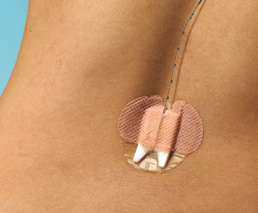Epidural anesthesia
Epidural anesthesia injection can be performed anywhere along the vertebral column and requires slow onset with large amount of injected substance.
Epidural anesthesia can be used:
• for pain relief
• as an adjunct to general anesthesia
• as a sole technique for surgical anesthesia, for example in Caesarean section
• for the treatment of back pain
• for the treatment of chronic pain or palliation of symptoms in terminal care
The Epi-Guard is specially designed to anchor the catheters used in epidural anesthesia.
Boqing Chen and Patrick M. Foye, UMDNJ: New Jersey Medical School, Epidural Steroid Injections: Non-surgical Treatment of Spine Pain, eMedicine: Physical Medicine and Rehabilitation (PM&R), August 2005.
Find out more
Leighton BL, Halpern SH (2002). “The effects of epidural analgesia on labor, maternal, and neonatal outcomes: a systematic review”. Am J Obstet Gynecol 186 (5 Suppl Nature): S69–77
Find out more


